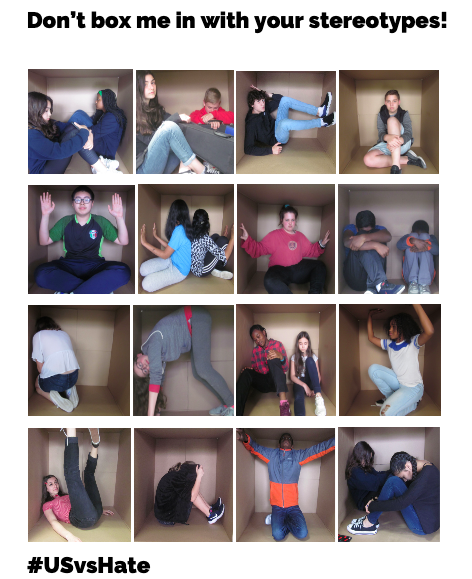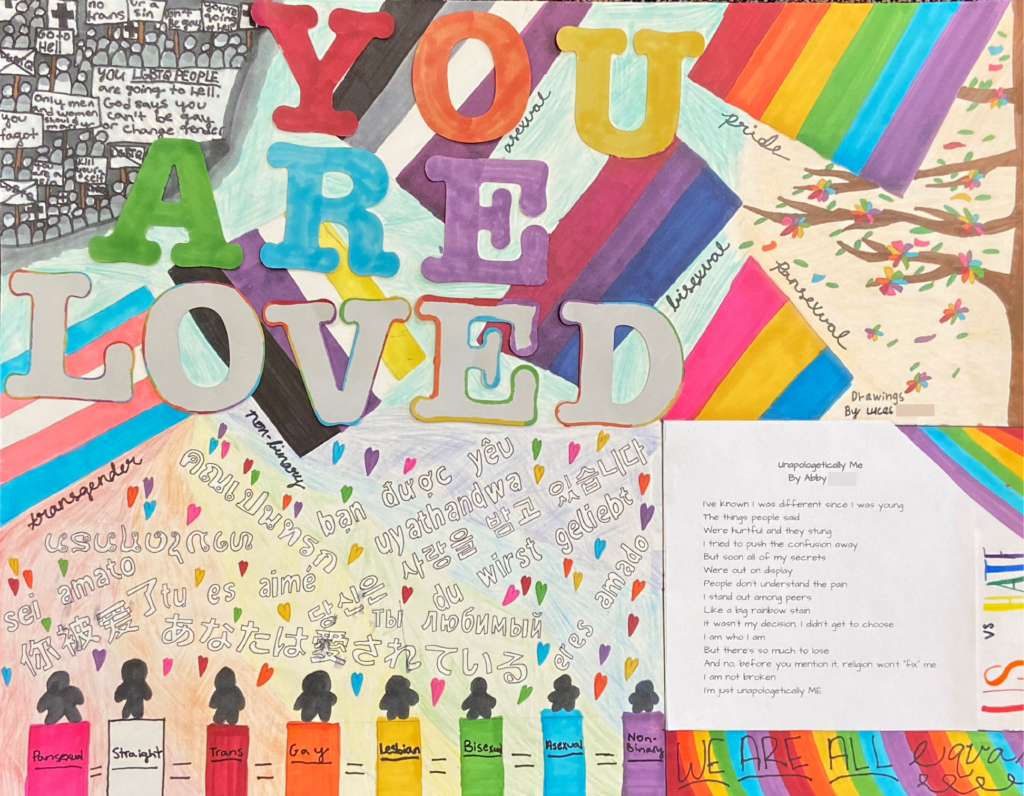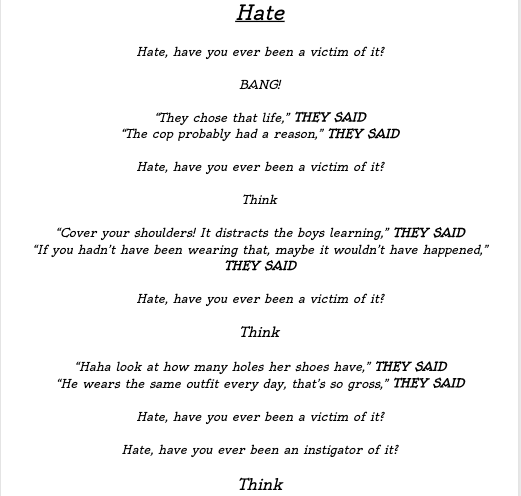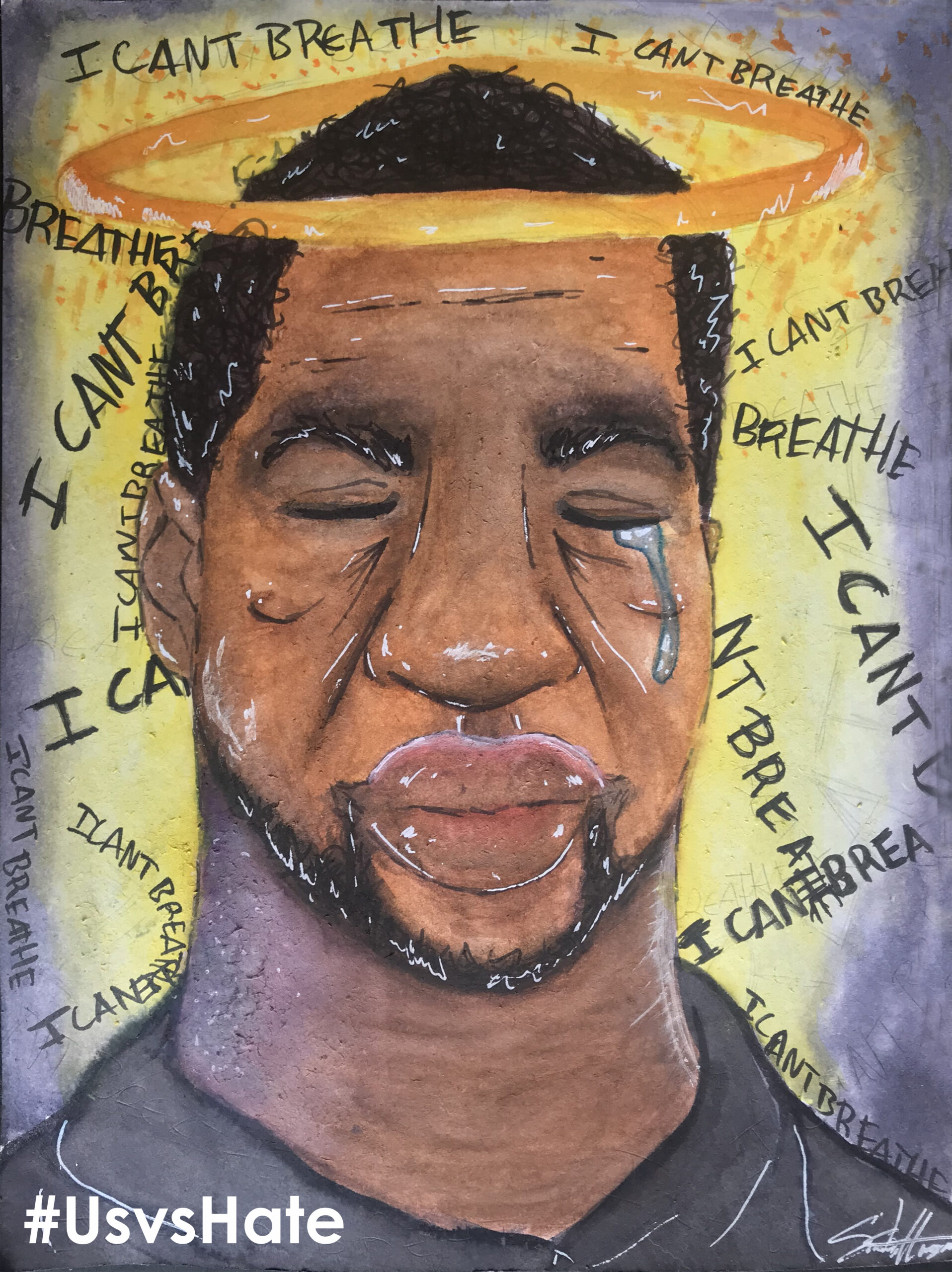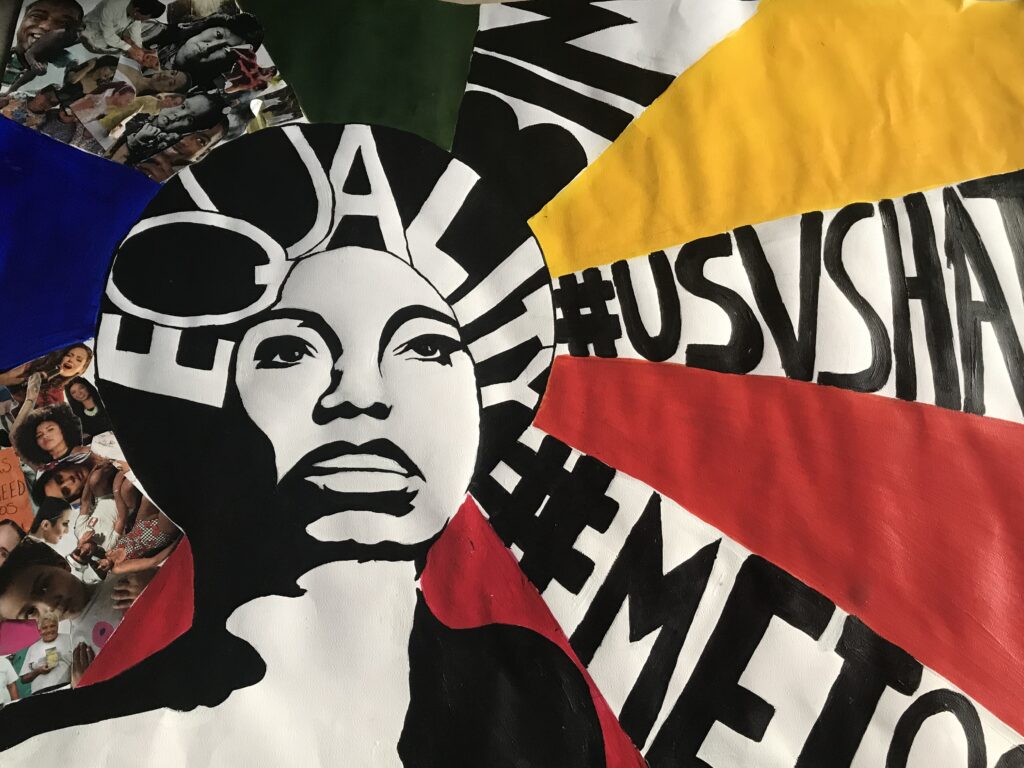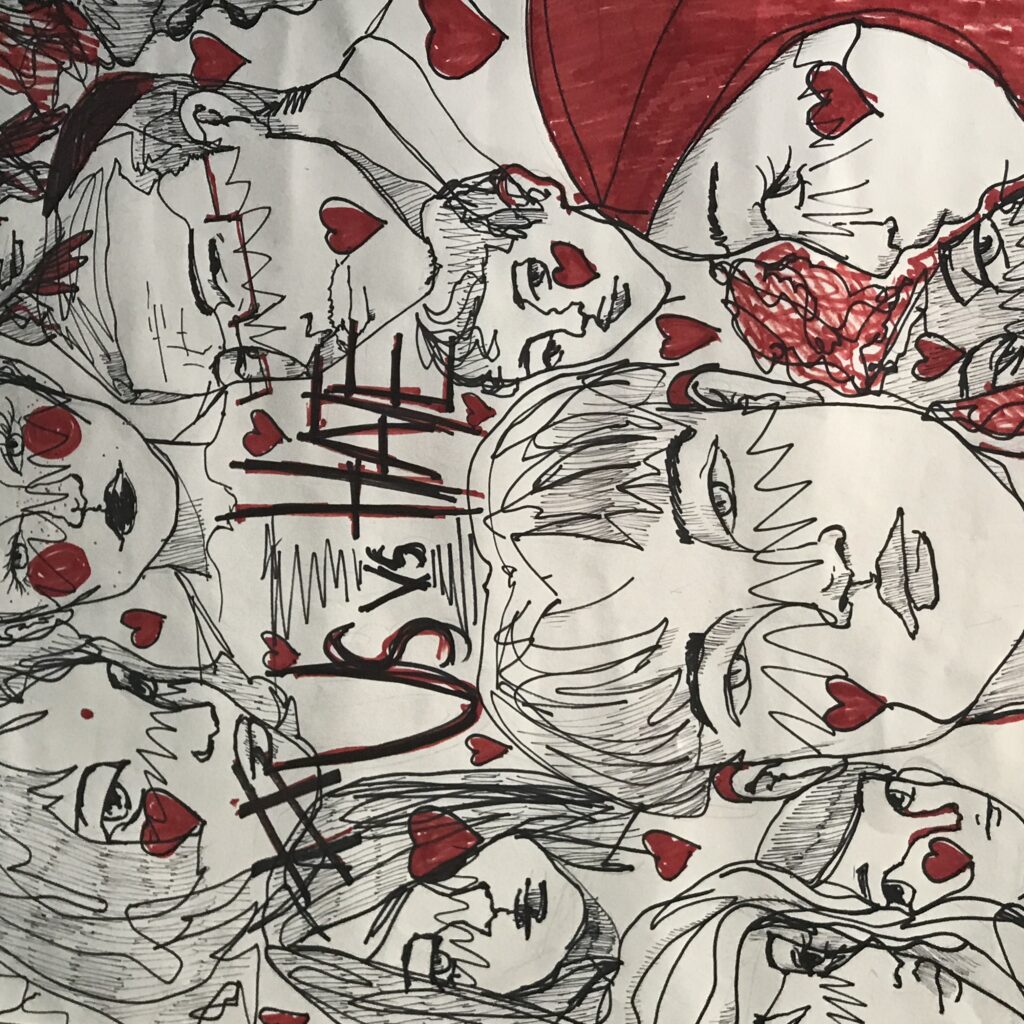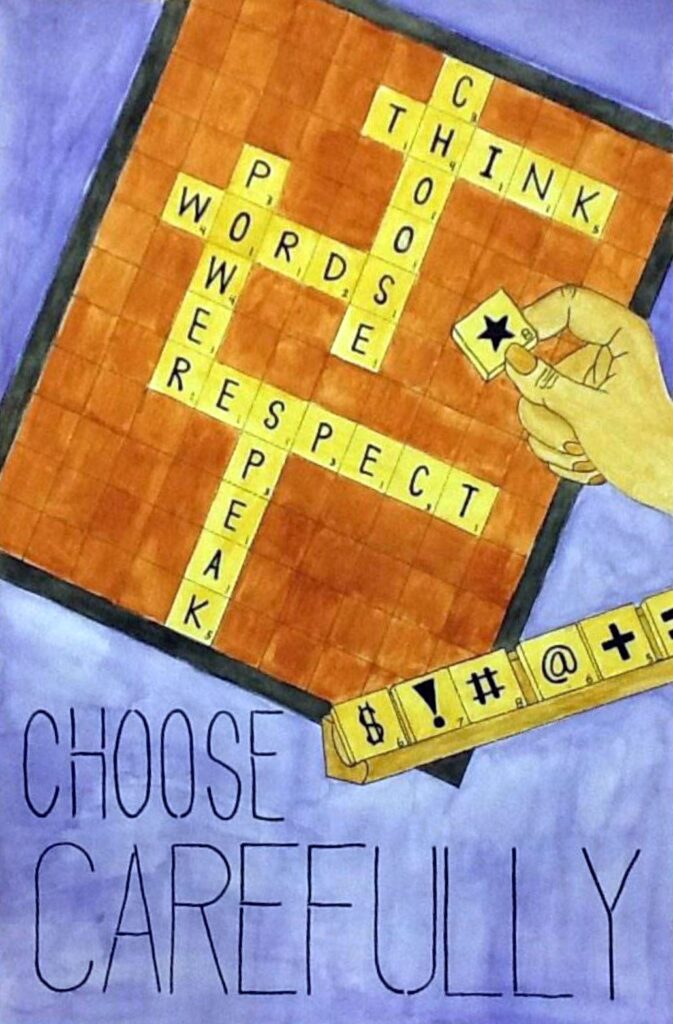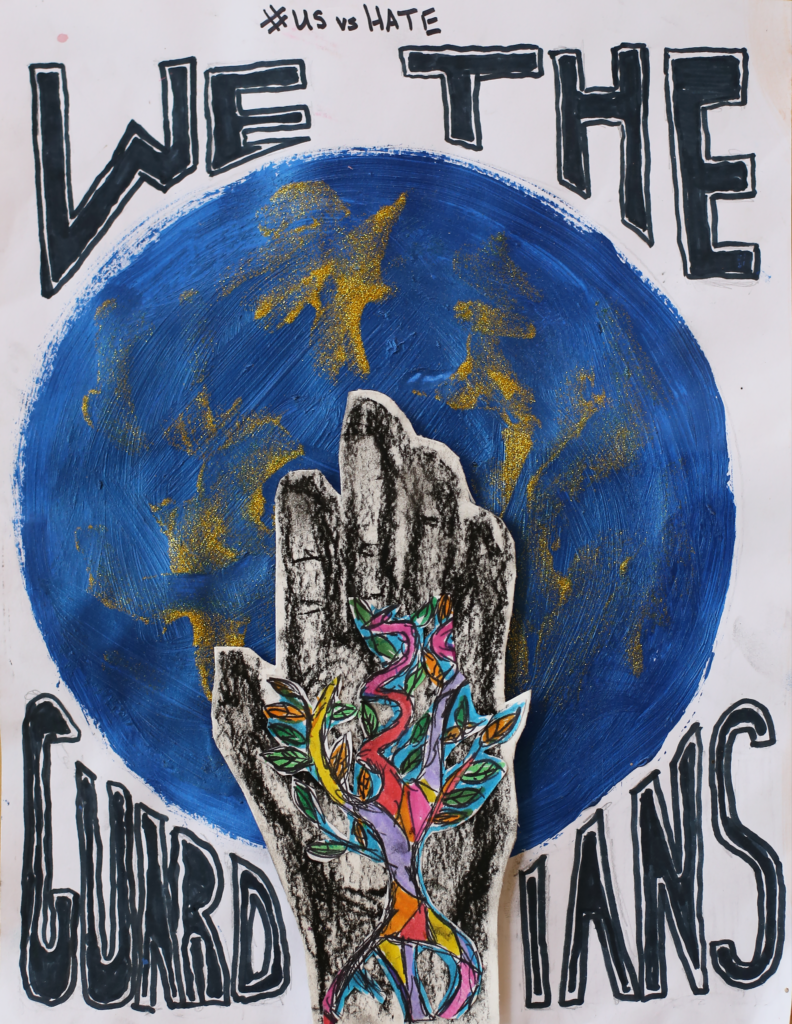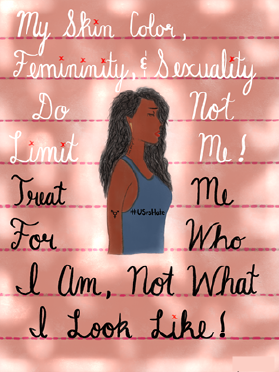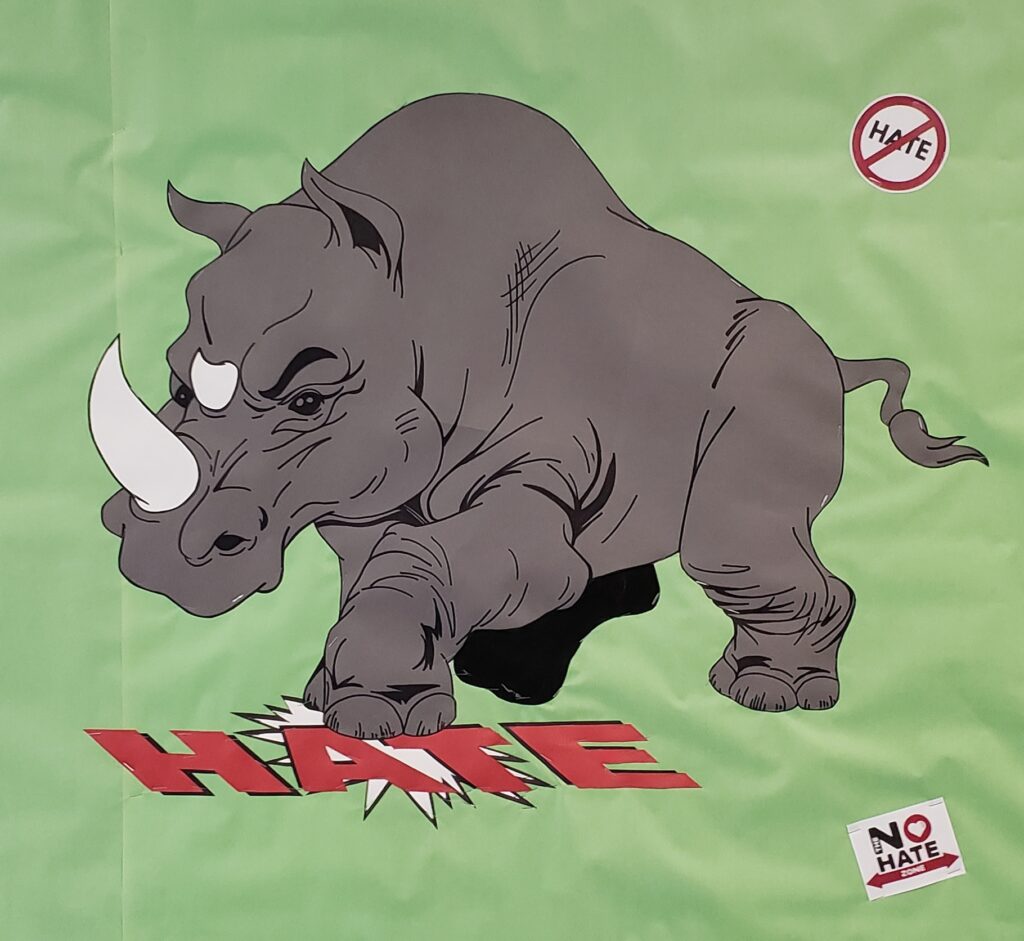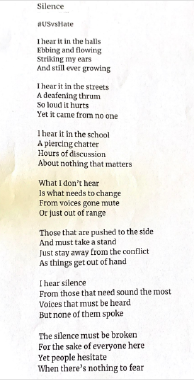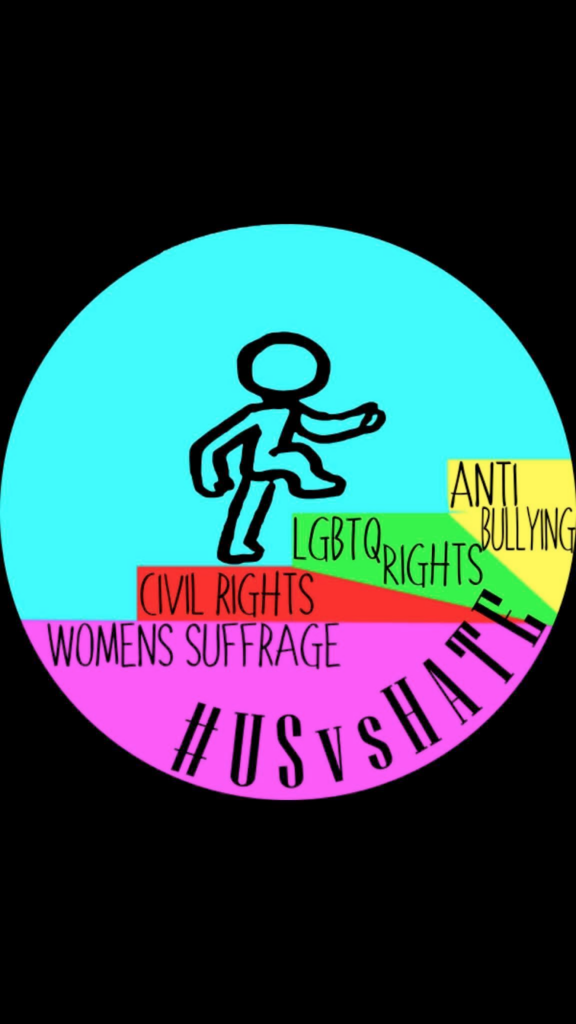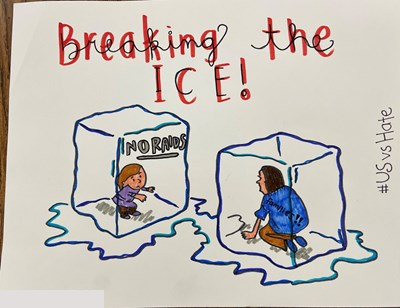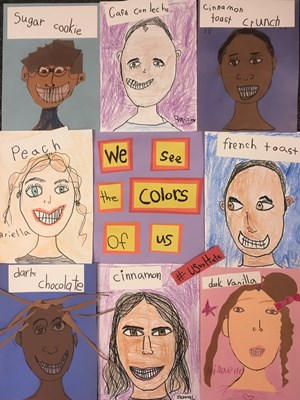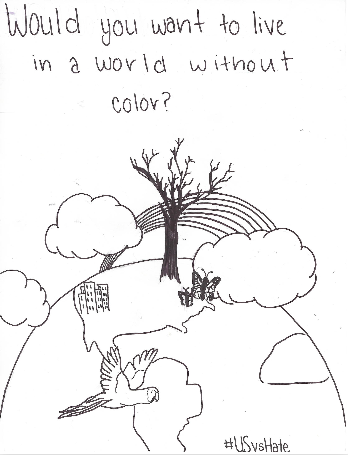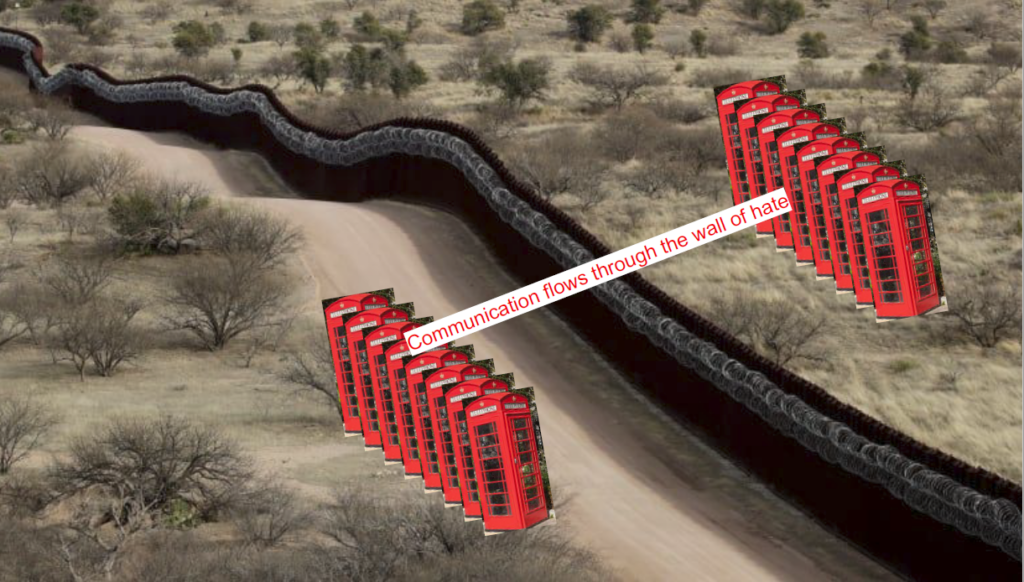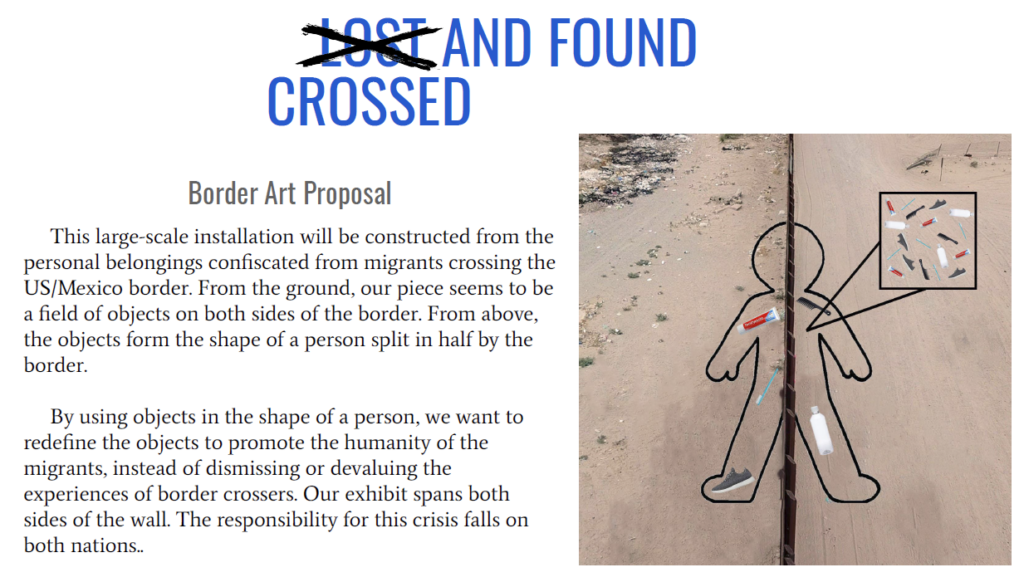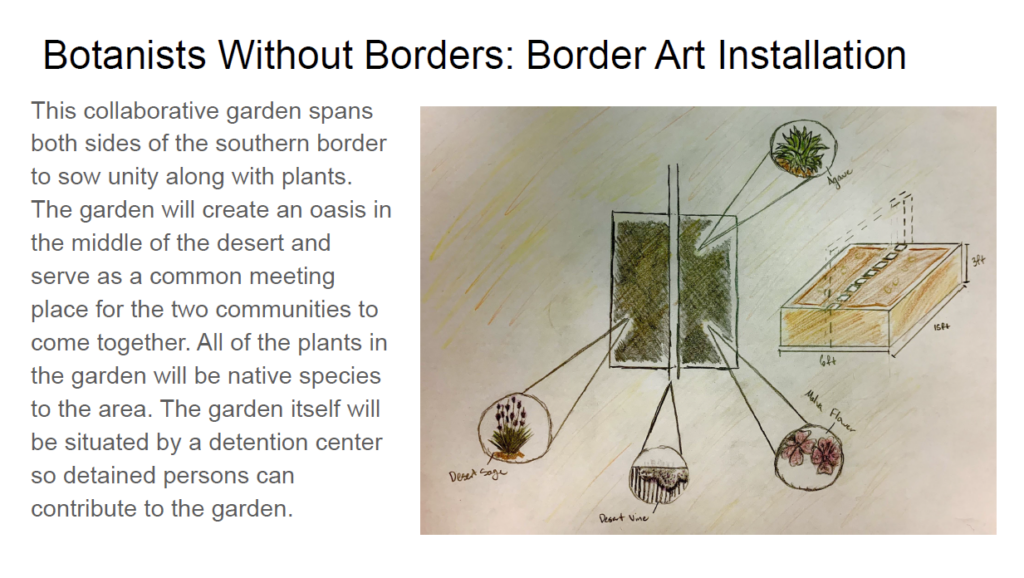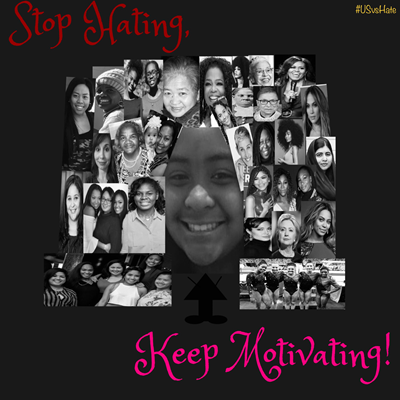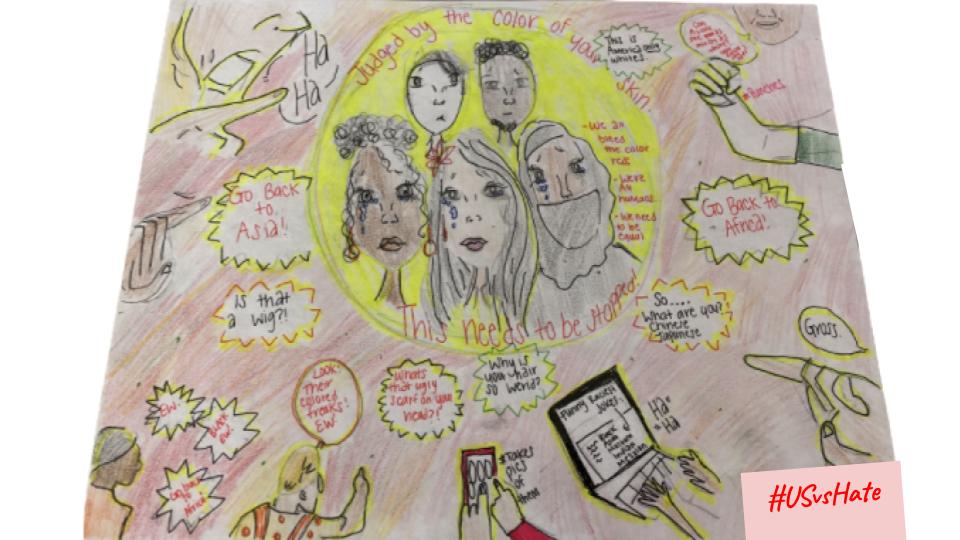Fall 2020 Winner
7-8th Grade Diversity Club, Farmington, CT
Teacher and club advisor Deborah Szabo explains, “Students prepared and taught an advisory lesson to fellow middle school students called #resist hate about how stereotypes can hurt and divide us. They created this poster for the day’s events.”
Fall 2020 Winner
Lily, Grade 8, Chula Vista, CA
Student creator Lily explains, “I just thought it was important to keep talking about racism & how it affects the black community. Black people are still being treated differently & killed at way higher rates than is ok.”
Teacher Carmela Golden explains the #USvsHate lesson she used to spark this messaging: “It was important to me to allow my students to choose their own topic when we began looking at anti-hate messaging. I tried to remain somewhat removed from the introduction, and chose the documentary movie Bully (2011) to bring the students in to the conversation. From there, we discussed different ways people are impacted by prejudice, discrimination, and hatred, and I allowed them to choose their own message.” This message also was judged a spring 2020 national winner by Teaching Tolerance judges.
Fall 2020 Winner
Lucas and Abby, Grade 6-8, Overland Park, KS
The student creators explained that “We would like to support the LGBTQ+ community because of all the hate they get from others. Also that it still isn’t fair for the LGBTQ+ people in this world. We just want to give them the love they deserve and to keep being themselves. (One peer) knows how it feels to be bullied because of (their) sexuality, and it’s tough.” Teacher Kelly Utley explains, “As a school student club, we wanted to spread the message of unity and love in a time of turmoil and unrest. Throughout flex classes, our students presented to every student in the school, first doing multiple hands on activities about unconscious bias in our school and action steps. We also surveyed the students anonymously to set an action plan to address unconscious bias in our school. We then had all students in the school submit their #USvsHate work as a culmination of all the work we had done throughout the year. . . We were planning to have a wall with all of the students’ work, not just the winners, but Covid19 has made that not possible. We are planning to create the wall as soon as we are physically back as a school. Our students are committed to this work as we move forward. We’ve held diversity meetings even though we’re not physically together to brainstorm how we can still carry this work forward as students looking to make our school and community a more accepting place.”
Their poem reads:
Unapologetically Me
I’ve known I was different since I was young
The things people said
Were hurtful and they stung
I tried to push the confusion away
But soon all of my secrets
Were out on display
People don’t understand the pain
I stand out among peers
Like a big rainbow stain
It wasn’t my decision I didn’t get to choose
I am who I am
But there’s so much to loose
And no, before you mention it, religion won’t “fix me”
I am not broken
I’m just unapologetically ME
Fall 2020 Winner
Niall, Grade 10, Perth Amboy, NJ
Student creator Niall explains, “I chose this because I saw a video of an Asian man getting abused for being Asian. People were yelling at him BECAUSE of this pandemic and I found it absolutely unfair and absolutely disgusting. I don’t think added incidents of racism will change the course of this pandemic. It only makes matters worse, so I thought it had to be put out there and designed my message to show that!” Teacher Heather Renaud describes the teaching behind the message: “I teach U.S. History with a focus on anti-racism, cultural relevance, social justice issues, and overall teaching for tolerance. When I learned about this call to action, I knew it was perfect for my students. Not only are they critical thinkers, they are so artistic and creative. They have so much to share! It was the perfect activity as we spend a lot of time in class discussing Latinx/Hispanic heritage, Black history, women’s history, along with current social and political issues. This was a way for my students to make commentary on issues that were important to them, and I am so proud of them!”
Fall 2020 Winner
Gianna, Grade 7, Media, PA
Poet Gianna “was inspired by author Jason Reynolds’ messages about social justice and equality, and by the structure and message of his poem/book, For Every One.” Teacher Tracey Fritch explains, “This past fall, my students worked on an author study reading and writing unit. Students chose from among a diverse group of authors and genre to select the author they would study. They worked in small groups to study the literary techniques and impact of the authors’ work, as well as the biography of that author – in order to learn about how that authors’ background and life experiences impacted their authorial choices. Gianna, and a few other students, had recently attended an author visit by Jason Reynolds at a local bookstore – and they were deeply impacted by his messages, particularly about his desire to have children feel that their ideas, interpretations, and imaginations are important – which is why he sometimes leaves his books with ambiguous endings. Students were impacted by his passion for all students seeing themselves, no matter their backgrounds, as capable of brilliance and having a voice. Gianna studied Jason’s work and life for several weeks, and then we returned as a group to some of Jason’s work in our more recent poetry study.”
Fall 2020 Winner
Sienna, Grade 8, Oceanside, CA
(submitted in May 2020, before a summer of national protests)
“This piece represents George Floyd who was wrongfully killed by a police officer in Minneapolis. George was held to the ground with the officer’s knee pressing on his neck for 9 minutes. George told the officer that he could not breathe 15 times hence why I quoted him 15 times on the page. George was a loving father and friend. His life will not be lost in vain.”
Fall 2020 Winner
Amy and partner, Grade 6-12, La Jolla, CA
Art teacher Tamima Noorzay explains the teaching behind this message: “One of the students created a beautiful observational portrait of Ms Simone using graphite in art last year, so in a way, it has been a sustained investigation for her over the last two years. The backstory is rich and grew partially out of our work with Baltimore artist Jay Schlossberg Cohen. He had really reached deep into the students over the course of three workshops during the fall/winter semester, bringing out each of their families’ history on coming to the US, the struggles and successes, how each of them planned to be agents of change, not only as the hero in their own journey using education as a vehicle, but also within their family, community and beyond. . . I felt inspired to move onto creating portraits of activists that the students were interested in. Students worked individually or in teams of two to research and present information about the activist they chose and why they chose that particular person. Additionally, they had to speak to the impact that the activism has had on society or the community/ies to which it was focused. Students had to substantiate the “activist work” by including context past and present and why they felt compelled to point a spotlight on this person. The range of selection was wide open from their own family members to well known public figures. . .students explored foundational leaders such as Gandhi, Rosa Parks, Dr King, Malcolm X, Sandra Davis, and Nina Simone to contemporaries such as Loujain al-Hathloul, Greta Thunberg and Chella Man. By presenting their research to their peers, they not only demonstrated their artistic process, but also educated us. Many of us became inspired to learn more about the activists we were unfamiliar with. Coming together with others who will help us reach our potential, every single one of us, because everyone matters, is to me the ultimate message of #USVSHATE.”
Student creators Amy and partner note of their message, “We chose Nina Simone because she struggled with mental illness and racism, but she was still able to express herself thru music and equality for the POC community. Her impact was that Nina used music to release her anger in the mistreatment of black people. Her music was a form of protest and influenced many black people to be enraged [about] inequality.” This message was also judged a national spring 2020 winner by Teaching Tolerance judges.
Fall 2020 Winner
Natalia, Grade 6-12, La Jolla, CA
See above for teacher Tamima Noorzay’s explanation of the teaching behind this message. Natalia, the creator of this message, explains: “I chose Chella Man because I see him as a leading figure in the LGBT movement for the future of the modern generation. I also really like his art and I stand for the same ideas he stands for. Him being a person of color also makes his message resonate with me even more. He as been a voice for voice for LGBT and disabled youth. His appearances in shows and in protest has made him a prominent face in the media.”
Fall 2020 Winner
Shoshana (she/her), Grade 8, Belmont, CA
Shoshana (she/her) wrote this winning poem, explaining, “My teacher asked us to write a poem and it just came out of me. My experience connects to my poem by watching the news and being surrounded by people who are served injustices every day. I submitted my poem to the #USvsHate campaign because I needed older people to know that even though I’m young I see what’s happening in the world and it is absolutely unacceptable.” Teacher Diana Roffman says, “We used the #USvsHate resources to look at art and poems and discussed different ways of expressing ourselves. We talked about how we can use our writing to creatively express our own emotions or take on perspectives of others. Students were then given the option to create their own pieces and Shoshana wrote this poem and expressed interest in submitting it to the #USvsHate campaign.”
Fall 2020 Winner
Naomi, Nikolas, Nina, Brayden, Ginny, Grace D., Grace F., Rowan, Alison, Lexi, Dom, Siena, Braedon, Skylar, Mattea, Maddy, Nate, Sandra, Eliza, Samantha, Zoey, Howie, Madison, Sam, Brooke, Casey, Becca, Daphney Civil Rights Club, Grade 7-8 Barkhamsted, Colebrook, New Hartford and Norfolk, CT
The Civil Rights club made this combination of art installations for their school. The students explain, “This is a tribute our club made to one of the greatest fighters for rights in our country’s history, Frederick Douglass! We did this in honor of the 150th anniversary of the passage of the 15th Amendment!” Teacher and club advisor Mike Stapleton adds, “This display was made by a group of Civil Rights Club students to challenge their classmates to make a difference and overcome hatred! The phrase ‘Are you ready to make a difference?’ surrounds a mirror. As students pass this each day they see themselves and hopefully ask themselves that question. The letters are covered with images of individuals who have made a difference!” (Note: in future, all art installation submissions should include the #USvsHate hashtag per challenge rules. We loved this one and accepted it anyway!)
Fall 2020 Winner
Anya, Grade 11, Studio City, CA
Anya explains some of the powerful thinking behind her powerful message: “The Coronavirus pandemic is reminding the Asian American community that their belonging is conditional. One moment we were Americans, the next we were contagious foreigners. Asian Americans have tirelessly persisted through oppression for years in the forms of alienization, otherization, discrimination, and racism, yet our struggle is overlooked and not acknowledged. Damaging stereotypes such as the model minority myth have caused Asian American struggles to be invalidated and unnoticed. Chinese Americans have historically struggled for their place in society ever since the Chinese Exclusion Act which was written to prevent Chinese Americans from succeeding. The anti-Chinese hate sentiment has since then continued to grow and is still reflected in modern day society. Because Asians are socially viewed as a “fake” minority, due to the model minority myth, the racism the community is currently facing is downplayed and not taken seriously. Growing up as a mixed Chinese and White individual, I have been able to see both sides of the community. The Chinese in my blood will always be seen as impurifying my Whiteness and our society has stripped me of having a mixed identity. As a mixed White and Chinese American, I have seen how ignorantly embedded Asian American hate is in our society and its values.”
Teacher Carlos Castellanos notes the teaching behind the message: “In March 2020 our school made the difficult decision to switch to remote learning in light of the COVID-19 pandemic. Teachers were asked to reevaluate their curriculum and make necessary adjustments to accommodate our new learning model. With so much going on in the world, I thought it would be a good idea to implement #USvsHate as the final project for 11th grade English class. It was the best decision I could have made for my students and for me.
“Our unit began with an exploration of how language surrounding the virus was starting to affect the way Asians (specifically Chinese people) were being perceived in the US. I used the lesson “Identity and Labels” from facinghistory.org, the article “Coronavirus: Sinophobia” from the Anti-Defamation League (ADL), and a short video from the NY Times titled “A Conversation with Asian-Americans on Race”. We used these to frame conversations about how the language used to talk about Coronavirus by the president and social media was starting to negatively impact our communities. We then continued our exploration of social justice learning through the use of various lessons from ADL (such as “The Pyramid of Hate” and “Swastikas and Other Hate Symbols”), as well as a variety of other videos from the NY Time’s “26 Mini-Films for Exploring Race, Bias, and Identity with Students”. I also supplemented these with some literary texts, such as the poem “Where Is My Country?” by Nellie Wong, “Grandmother’s Tongue: Inheritance” by Leah Huizar, and Zora Neal Hurston’s short story “How It Feels to Be Colored Me”.
“Halfway through our #USvsHate unit, we learned about the unfortunate deaths of Ahmaud Arbery, Breonna Taylor and George Floyd. We also learned about the incident with Christian Cooper in Central Park. As such, we were able to witness injustices toward the Black community unfolding right before us. We were able to make real-time connections to the material we were learning, which on the one hand left us feeling heavy after many class discussions, but on the other made our mission with #USvsHate that much more timely and valuable.
“On the last day of school, students presented their anti-hate messages, and I was overwhelmed with pride by what they had produced. I’m grateful to #USvsHate for providing the platform and resources to do this work. Because of #USvsHate, my students will be able to look back at these times and know that they created some positivity and light in the world when it needed it most.”
Fall 2020 Winner
Valeria, Grade 11, Studio City, CA
See teacher Carlos Castellanos’ take above on the teaching behind this message. Student creator Valeria explains: “From watching a video in class called ‘A Conversation With Black Women on Race,’ this quote stuck with me: ‘You’re not good enough, your hair isn’t good enough, your clothes aren’t good enough, and we’re going to make sure everyone notices that you’re black and everyone else isn’t.’ This is important to me because what is seen in the media and described as ‘beautiful’ and ‘desired’ is used against African American women to make them feel ‘unworthy’ or ‘ugly’ in society’s eyes. . . .Our future as a society will become more aware and accepting once hate within oneself is shut down.
“Being a plus sized Latina in America, I face judgement all the time. By what I see in the media and all over, my own experience is one of millions around the world that suffer from the hatred/judgement women and men face for their outward appearance. I feel and believe wholeheartedly that we need to break away from that toxic and negative way of thinking and just let people live the lives they want and choose to. People shouldn’t change who they are just because society and beauty standards say that it’s ‘wrong’ or ‘frowned upon.’ These are set by implicit biases against race, size, gender, etc. and these ‘expectations’ are encouraged. Different is considered ‘ugly.’ Things have been this way for centuries and we need to be the generation that stops this cycle of self hate that comes from the idea that what we look like matters more than the content of our souls and characters. Beautiful is whatever you make it, not what others say it has to be. Write your own narrative and make sure that you blossom into the person you want to be in this world. Everyone is beautiful in their own ways, and once that’s realized you will hold the strongest form of magic in the world, love. That feeling will be felt towards yourself, and then can be spread around because it’s such a powerful force. That’s the reason I feel so strongly about this movement, because any type of positivity that could be found is needed so desperately in this cruel world full of hate.”
Fall 2020 Winner
Grade 12, West Los Angeles, CA
The student creator explains, “This is an anti-bullying poster. The slogan is choose carefully. I used a scrabble board to show how much of an impact words can have on others, and that we have a choice to speak with encouragement instead of hate. The perspective is from the person deciding on what word to use. The scrabble letters the person has are symbols to represent hurtful curse words that could be made and the symbol tiles have a higher point value (in bottom corner of each tile) to represent the power of language.” Art teacher Pattie Kraft engaged 200 of her students in #USvsHate, with all messages displayed in the school.
To see more of her students’ #USvsHate work, click here.
Fall 2020 Winner
Ajah, Alyssa, Chiara, Joshua, Matwau, Monix, Valeria, Ximena, Yahel, Zoe Grade 6-8, San Diego, CA
Teachers/co-advisors Kyle Weinberg and Laurie Bailon-Yagyagan explain, “This comic book was created by our school’s Chavista Social Justice Project as our 18-19 school year service learning action project. Student members of the Social Justice Project develop their knowledge and skills around identity, civic engagement and leadership and carry out a service learning project to be part of the solution to problems that they identify. Last year, they chose the theme of being an “upstander” to discrimination based on race, gender and sexual orientation and created and performed a play for students, family and community members. This year, we participated in a human rights institute with the American Friends Service Committee and produced the Youth Justice Squad comic book in collaboration with Little Fish Comic Book Studio and One Book, One San Diego featuring the “Battle at the Border”, applying lessons learned about people working together to promote humane treatment for those in need.” This message was also judged a national winner by Teaching Tolerance judges in spring 2020.
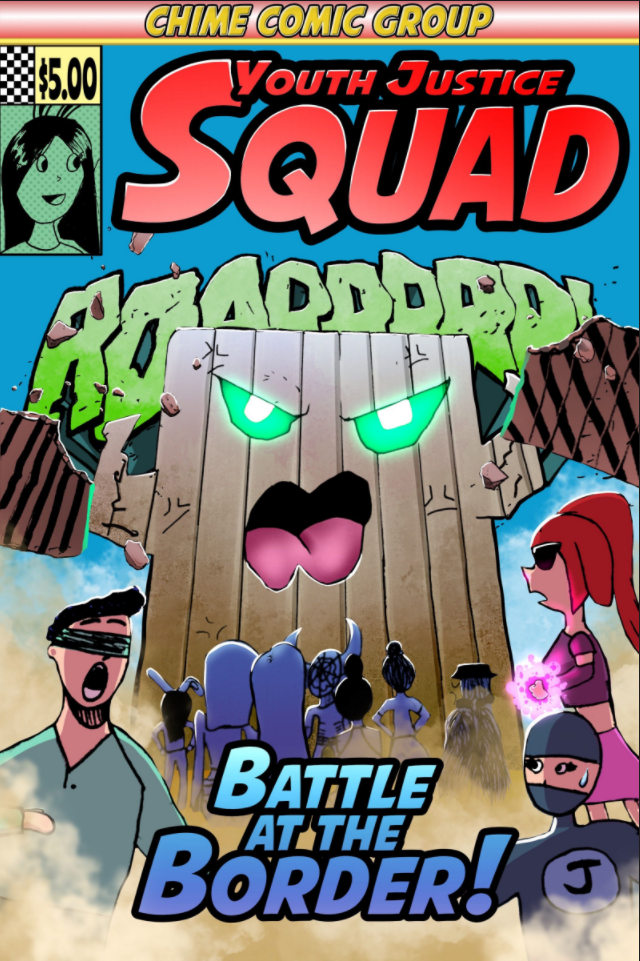
Fall 2020 Winner
GSA, Grade 5, WI
Student creators of this message explain that their school’s GSA believes “Words Matter.” “Our Message: Use names and pronouns correctly. Gender and sexuality are a part of our identity, not put-downs. Words have history, especially with regard to race and ability/disability. Think before you speak. Choose kind. Be an ally. Please enjoy our video to hear more about why words matter. Thanks to the brave 5th graders who come to the GSA and helped bring our message to life!”
Teacher SJ explains the learning behind the message: “I am a queer nonbinary art teacher in my third year at our school. At the beginning of the year, some of my 5th grade students asked me if we could start a GSA, or Gender and Sexuality Alliance. We have 20+ students coming to our weekly GSA meetings. We discuss topics such as coming out and self esteem, design posters for local LGBTQ events and Black Lives Matter Action week, present student-researched and student-led “institutes” on topics such as Stonewall and LGBTQ around the world, and read and discuss books like George by Alex Gino. One of our most recent creations was this video for Words Matter Week.” This video was also judged a spring 2020 national winner by Teaching Tolerance judges.
Fall 2020 Winner
Lily, Middle School, Shelburne, VT
Student creator Lily explains simply, “We are the guardians.” Teacher Rebekah Hopkinson shares the teaching behind the message: “Our middle schoolers engaged in an immersion block studying climate change in our school’s social justice, art & activism program, Unbound. In this block we sought to build resilience so that students can meet whatever comes with hope and flexibility, seeking out others who can help them and work on climate solutions together. Students were immersed in activities that helped deepen their relationship to and respect for the Earth, learning about what animals are thriving and what is in danger, and discovering what organizations are working to help. The students were engaged in different art forms such as mask making, painting, clay, music, poetry, and acting. Our aim was to heighten awareness of our interdependence in the living
body of Earth and to strengthen our commitment to defend it. The process served to help us acknowledge and give voice to the suffering of our world. It also served, in equal measure, to help us experience the beauty and power of our interconnectedness with all life and the innate power in all beings to heal themselves. This poster captures the depth of thought and care and the personal responsibility that our young people feel for the earth. We are the guardians.”
Fall 2020 Winner
Julia, Grade 11-12, Plantation, FL
Student creator Julia explains that, “The message I am trying to convey in my artwork is that no one, no matter their race, gender, or sexual orientation, should be judged on their physical appearance. People’s external appearances should not limit their opportunities such as what income they make, what job they receive, or the treatment they receive from other people. Individuals should be accepted for who they are and what they have to offer.” Teacher Lara Herrera explains the teaching behind the message: “I have had the pleasure of teaching both psychology and sociology to the same group of students this year, so we have examined the individual experience from both a macro and micro perspective. The students recently completed a unit of study themed ‘social inequality,’ so participating in #USvsHate seemed like a fitting way to showcase the ideas they were most passionate about, including social stratification related to gender, race/ethnicity, and social class. We utilized numerous resources from Tolerance.org and analyzed our own hidden biases and life experiences. We also had many open, honest, and sometimes emotional classroom discussions. I am proud to provide a safe, supportive space for facilitating these conversations.”
Fall 2020 Winner
Camille, Kiana, Olivia, Clarissa, Tessa, Solana, Kaia, Kayla, Katherine, Paul Student Ambassadors, Grades 7-8, Fort Lee, NJ
Student creators shared that “Bulletin boards with positive school messages are created every couple of weeks in our main lobby by members of our Student Ambassador team.” Art teacher and Student Ambassador Advisor, Nina Anderson, describes how the students “created a message on a 12 foot bulletin board to help promote our school’s character education program and support the #USvsHate initiative. The Ambassadors are a select group of students dedicated to preventing disharmony and bias behavior while helping to maintain cooperation and unity within the middle school student body. The students who are selected to the program serve as role models for our school in numerous capacities. The main goal of this group is to facilitate and promote a positive school climate while making sure all students feel safe, included, and welcome in our building at all times. Each month our Student Ambassadors focus on different class lessons that are both teacher and student driven and reinforce the lessons with creative bulletin board displays.”
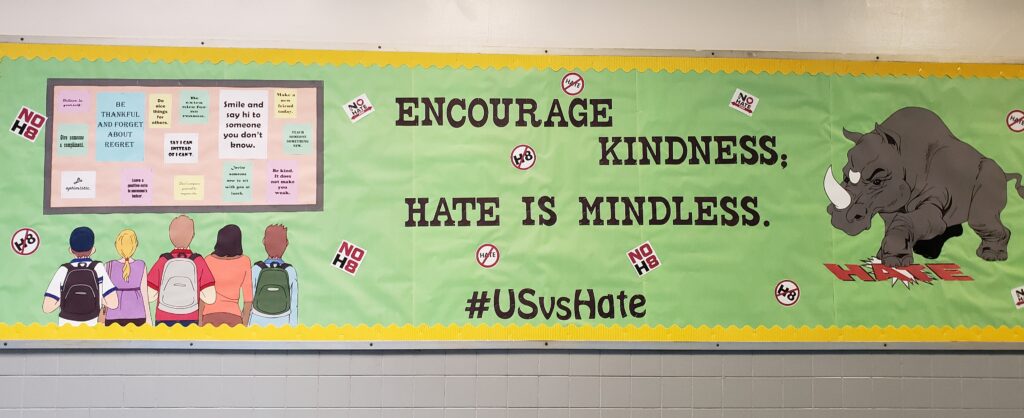
Fall 2020 Winner
Ivy, Grade 6-8, San Diego, CA
Teacher Kylie Ripley explains, “Ivy participated as a peer trainer in No Place For Hate at our school this year.”
Fall 2020 Winner
Madison, Grade 4, Chula Vista, CA
Student Madison explains, “I feel I have a passion and voice for inspiring change with gender equality.” Teacher Rachel Ortiz describes the process behind the message: “Our classroom started off the year with wanting to build our community. In doing so, we saw a need to address identity and stereotypes. Many students felt they didn’t have a voice at school or a safe place to have discussions. We used lessons from Teaching Tolerance and the Human Rights Campaign on identity. Even though some of the lessons were stated as K-2nd grade, I found them very usable. We read books like, It’s Okay to be Different by Todd Parr and Looking Like Me from Walter Dean Myers. Students made “It’s Okay” statements and placed them around school campus. We wrote “I Am Me” poems that we shared with our younger grade buddies. Lastly, students had an opportunity to write a speech/TED Talk on what they are ‘Looking Forward To.’ Many students wrote about a world of peace, rain forest deforestation, medical advancements, bully-free, and some wrote about gender equality. Madison was selected as a recipient to speak in front of the entire school and then was selected to speak at our district regarding her topic.”
Click below for Madison’s TED Talk.
Fall 2020 Conversation Starter
Noel, Grade 6, Lakewood, WA
Noel describes why his #USvsHate message matters to him in this powerful video: https://youtu.be/Lh5jUNrURW4
Teacher Miriam Robinson describes, “Students read the novel Roll of Thunder Hear My Cry by Mildred Taylor. To create background knowledge they watched the film “The Children’s March” by Teaching Tolerance. They spent months learning about racism, equality, segregation, Civil Rights, Civil Rights leaders, through discussion and seminar. Our school is a bright spot because even though we have some challenges like high poverty (80% low income) and transient populations we have lots of successes. I believe our success has to do with providing a curriculum that represents our diverse population and also challenges them to explore difficult subject matters. These students did this work all on their own and with much effort. The student creator Noel not only created this sticker but printed and cut one out for all of his classmates.”
Fall 2020 Conversation Starter
Laurinne, Grade 10, Chula Vista, CA
Teacher Kalie Espinoza describes the teaching behind this powerful conversation starter, “In English 10, students read the novel A Thousand Splendid Sons and watched the TED Talk “Danger of a Single Story”. We discussed how complex identities are formed and how motivations are a result of those unique perspectives. Most importantly, we connected it to the larger purpose of literature and art being a way to communicate through lines of difference so that we can better understand people and societies with who we don’t have daily contact.”
Fall 2020 Conversation Starter
First Grade Class, El Cajon, CA
“My first graders see color,” says teacher Ingrid Siss-Feliciano. “At 6 years old, they recognize their differences and they are already impacted by implicit biases. They walk through this world with different experiences and they receive messages about who they are based on the color of their skin.” In response to my students’ conversation ( “He is brown like a donkey!” one student said. “Hey! That is racist!” another student shouted), we read a book called The Colors of Us by Karen Katz. In the story, a young artist paints a self-portrait and wants to use brown paint for her skin color. She and her mother walk around the neighborhood and discuss how there are various shades of brown. It is a celebration of diversity that shares positive ways to talk about skin color. Our class talked about how there are ways to describe skin color that feel good and sound like compliments, and there are comparisons that feel like insults. For example, comparing skin color to an animal, like a donkey or a worm doesn’t ‘feel good’. We also talked about how skin color is tied to identity. Students shared how they would like to describe their skin color. The class made their own self-portraits and students that wanted to, added their skin color descriptions to the portraits. My students see color. They see the colors of us. They felt empowered to share how they describe their skin color. They walked away from this experience celebrating the different skin tones we have in our classroom and with a better understanding of how to have respectful conversations about race.”
Fall 2020 Conversation Starter
Anthony, Middle School, La Jolla, CA
Anthony explains: “I made this piece because I have seen and learned about skin color and other differences dividing humans, and I wanted to make a comparison about how without color, our world would not be as beautiful and great, similar to how it would stink to live in a world without our differences.” Teacher Vanessa Van de Vanter explains, “Each unit we try to connect to issues that started during ancient times and carry on to this day. This unit was about Africa and how agriculture and geography played a role in the colonization of Africa by European powers. We draw from the Big History Project and Guns, Germs, and Steel by Jared Diamond. I asked the students to create a visual based on what we learned.”
Fall 2020 Conversation Starter
Red Vessels: Luke, Megan, Harrison Crossed and Found: Emily, Layne, Kathryn Botanists without Borders: Zachary and Erin Grade 9-12, El Segundo, CA
Teacher Sarah Older Aguilar explains the teaching behind the message: “For this unit of study, students were asked to imagine and propose an art installation or performance art piece on the U.S./ Mexico border. Their design concepts needed to respond to the following question: What message would you like to add to the broader conversation about America as it is envisioned through the U.S./ Mexico border? This project was part of a larger unit about the national debate over security and immigration on our southern border. Students read news articles, essays, poetry, and short fiction to develop an understanding of border policy, politics, and representation. We began our study with the following assertion: the U.S.- Mexico border is both a material reality and a metaphor that constructs national identity and nationhood. Our essential question was: how does the imagination of the border confirm, expand, or challenge our national narrative of belonging and achieving the American Dream? Students also learned about several art installations at the border, and analyzed the rhetorical strategies of each piece, before designing their own.”
Fall 2020 Conversation Starter
Rony, Grade 6, Chicago, IL
Message-maker Rony notes her message: “I chose the theme sexism because women should be treated equally as men. I want people to know that we should all have equal pay, we should all be respected, and we should all have the chance to be what we want to be when we grow up. . I created a picture collage of the women who have stood up for other women, and women who are important in my life that tell me to be a strong female. When you look at my creation, you will see a female, which is me. In her hair are all the women who play an important part in her (my) life. I put famous women who stand up for themselves and other women I look up to. I also added the women in my life who teach me to be confident in myself, who tell me I can be anything I want to be. I chose to put the pictures of the women in my hair because when people first meet me, they notice my big hair. My unique hair makes me who I am and these women are a big part of who I am. I said “keep motivating” because women should be motivated, not held back. All these women motivate me to be the best I can be.”
Teachers Angela Benavides and Nicole Small describe their process with #USvsHate: “This year, the students took part in units about equity across cultures, races, and socio-economic status. We used materials from Teaching Tolerance, Flocabulary, BrainPop, Share My Lesson, plus teacher-curated materials to highlight BLM in schools, immigrant and migrant issues, and how race and poverty go together in our city. The students learned about forms of peaceful protest and leaders through time that affected history (Civil Rights, women’s voting rights and equal pay for equal work, how immigrants shape our country, disparate treatment of people of color). We studied historical examples of empowerment through peaceful protest and non-violent resistance, and the leaders who paved the way, such as the California Grape Boycott (Cesar Chavez & Dolores Huerta), March on Washington (John Lewis & MLK), migrant workers’ rights (Maria Moreno), and the Black Lives Matter movement (Alicia Garza, Opal Tometi, & Patrisse Cullors). They learned first-hand about peaceful protests during the Chicago Teachers Union strike this year which had schools closed for 11 days. Many of these students and parents joined picket lines and made posters in solidarity in the common goal of more resources for the students, safe and clean places to go to school, and more wrap-around services (like a nurse, social worker, and counselor in every school). A lot of our students are children of immigrants or immigrants themselves, so they identified with groups who were/are “othered” in our society. In each individual unit, the students brought it back to how today’s youth can lead by example to create a better place for us all to live. In assigning the #USvsHate challenge, the students applied what they learned at school, what they see around them, and what is happening in their own lives to get inspiration for their projects.”
Fall 2020 Conversation Starter
Jacqueline, Grade 7, Chelsea, AL
Teacher Charlsie Wigley notes, “This message comes from things that students have heard in the hallways of our schools as well as on social media outlets. The Asian comments specifically come from the artists’ experiences as a young Asian American. The message was constructed at the end of a Holocaust Literature Circle unit during which students read memoir accounts from survivors who were children and teenagers who suffered at the hands of antisemitism. While students not only read and worked collaboratively in groups to discuss the text they were reading, they also learned about the origins of antisemitism and antisemitic propaganda. I had the fortune of visiting Poland on a teaching learning journey through Echoes and Reflections, so students also learned from much of the information that I gleaned from that experience. Finally, just before I issued this as a challenge, students responded to each other through an online messaging board I had set up regarding making connections between what they had learned through their book and lit. circle and class discussions as connected to current issues of discrimination in specific institutions (justice system, media outlets, school, literature, etc.) This student wrote on the discussion board about some of the discrimination that she has faced at school which I believe led her to reflect on those ideas in this message.”
